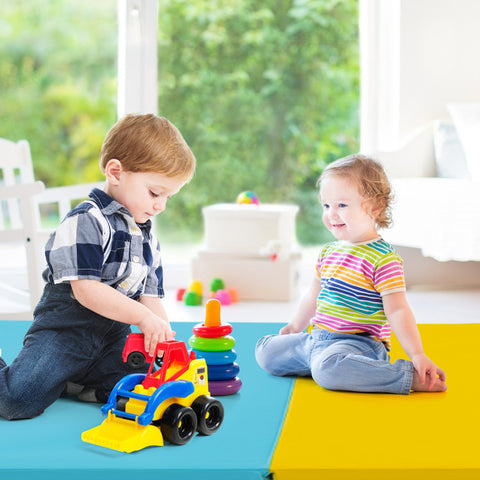News
Temperature Resistance in Gymnastics Mats: How Climate Affects Performance and Durability
While gymnastics mats are designed for strength, stability, and comfort, one factor that often goes unnoticed is temperature resistance, the ability of a mat to maintain its performance and structure under varying temperature and humidity conditions.
From hot gym floors in summer to cold training halls in winter, temperature fluctuations can significantly impact the foam density, grip, flexibility, and safety of gymnastics mats. Understanding how materials react to these changes is vital for athletes, coaches, and facility managers who want to maintain consistent training standards.
What Is Temperature Resistance in Gymnastics Mats?
Temperature resistance refers to how well a mat’s core materials (foam, vinyl cover, and adhesives) can withstand temperature changes without losing their shape, texture, or performance quality.
A temperature-resistant gymnastics mat should:
- Maintain consistent foam compression and rebound.
- Resist hardening or softening due to temperature shifts.
- Prevent surface cracking or peeling in extreme conditions.
This ensures that the mat performs reliably year-round, regardless of the climate or indoor environment.
The Science Behind Temperature-Resistant Materials
Gymnastics mats are typically composed of foam cores encased in vinyl or PU leather covers. Each material type reacts differently to heat and cold:
- Closed-cell polyethylene (PE) foam: Excellent temperature stability. It resists moisture absorption and doesn’t harden easily in cold environments.
- Polyurethane (PU) foam: More sensitive to heat and humidity, often softening under high temperatures.
- EVA foam: Highly resilient and lightweight; maintains elasticity across temperature variations.
- Vinyl covers: When treated with UV and heat stabilizers, they prevent surface discoloration and cracking.
Manufacturers may use temperature stabilizers, anti-UV coatings, and thermal bonding adhesives to enhance overall resistance.
How Temperature Affects Gymnastics Mat Performance
The performance of a gymnastics mat can shift drastically under temperature extremes.
1. High Temperatures (Above 30°C / 86°F)
- Foam may soften excessively, reducing stability during landings.
- Surface vinyl can become sticky, increasing friction and discomfort.
- Glue joints may weaken, causing delamination over time.
2. Low Temperatures (Below 10°C / 50°F)
- Foam hardens, losing flexibility and impact absorption.
- Vinyl surfaces become stiff, increasing the risk of surface cracks.
- Reduced rebound makes tumbling or flips more physically demanding.
Maintaining a moderate temperature (18–24°C) is ideal for preserving both comfort and safety.
Why Temperature Resistance Matters
- Consistent Safety
A mat that hardens in the cold or softens in the heat can compromise safety by reducing shock absorption or surface traction.
- Extended Lifespan
Temperature-resistant materials retain their elasticity and strength longer, preventing premature wear or foam degradation.
- Performance Reliability
Professional athletes require consistency. Temperature-stable mats ensure uniform landings and predictable rebound, reducing training adaptation time.
- Maintenance Efficiency
Mats that handle temperature variations better require fewer repairs and replacements, reducing long-term costs.
Ideal Material Specifications for Temperature-Stable Mats
To ensure optimal temperature resistance, look for mats with:
- Foam Density: 3–5 lbs/ft³ for balanced flexibility and resilience.
- Material Type: Closed-cell PE or EVA foam for minimal thermal expansion.
- Covering: UV-protected vinyl or reinforced PU leather.
- Adhesive Quality: Heat-activated bonding that resists delamination.
- Testing Certifications: EN 12503 or ASTM F2772 compliance for thermal and performance stability.
These technical features ensure durability even under challenging environmental conditions.
Storage and Care Tips for Temperature Maintenance
To protect your gymnastics mat from temperature-related wear:
- Store indoors in a temperature-controlled environment.
- Avoid direct sunlight to prevent UV damage and material softening.
- Do not store near heaters or vents, as excessive warmth can break down adhesives.
- Allow acclimatization time when moving mats between hot and cold environments.
- Clean with mild, cool water instead of hot solutions to avoid warping.
Proper handling can extend the lifespan of your mat by years.
Environmental Adaptation: Gymnastics Mats for All Seasons
Manufacturers now design multi-climate gymnastics mats that perform consistently across different regions. These mats use thermally adaptive foams that self-adjust stiffness based on ambient temperature.
For example:
- Cold-resistant mats retain flexibility even below freezing temperatures, ideal for unheated gyms.
- Heat-resistant mats maintain firmness in high humidity or tropical climates.
This innovation ensures performance stability across international competitions and varying gym conditions.
Conclusion
Temperature resistance is a silent performance factor in gymnastics mats — often unnoticed until problems arise. A temperature-stable mat ensures reliable shock absorption, consistent grip, and long-lasting durability, regardless of environmental conditions.
Investing in a temperature-resistant gymnastics mat isn’t just about comfort — it’s about ensuring safety, consistency, and performance excellence in every training session, all year long.
FAQs
1. Can temperature changes permanently damage a gymnastics mat?
Yes. Extreme heat can weaken adhesives, while cold can harden foam, reducing its shock absorption and flexibility.
2. What type of mat is best for outdoor use?
Choose UV-protected and heat-resistant mats made from closed-cell PE or EVA foam for outdoor conditions.
3. How do I test if my mat is temperature resistant?
Press on the foam after exposure to temperature changes. If it retains firmness and rebounds quickly, it’s temperature stable.
4. Can I use a space heater or fan to adjust mat temperature?
Avoid direct exposure — it can damage material. Instead, control room temperature evenly.
5. Do professional gymnastics facilities use temperature-controlled rooms?
Yes. Most professional gyms maintain a stable indoor climate to preserve equipment and ensure consistent training conditions.


